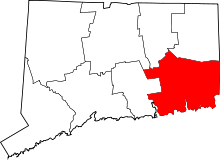New London, Connecticut
| City of New London | ||
|---|---|---|
| City | ||
 New London skyline from Fort Griswold | ||
| ||
| Nickname(s): The Whaling City | ||
| Motto(s): Mare Liberum | ||
|
Location in New London County, Connecticut | ||
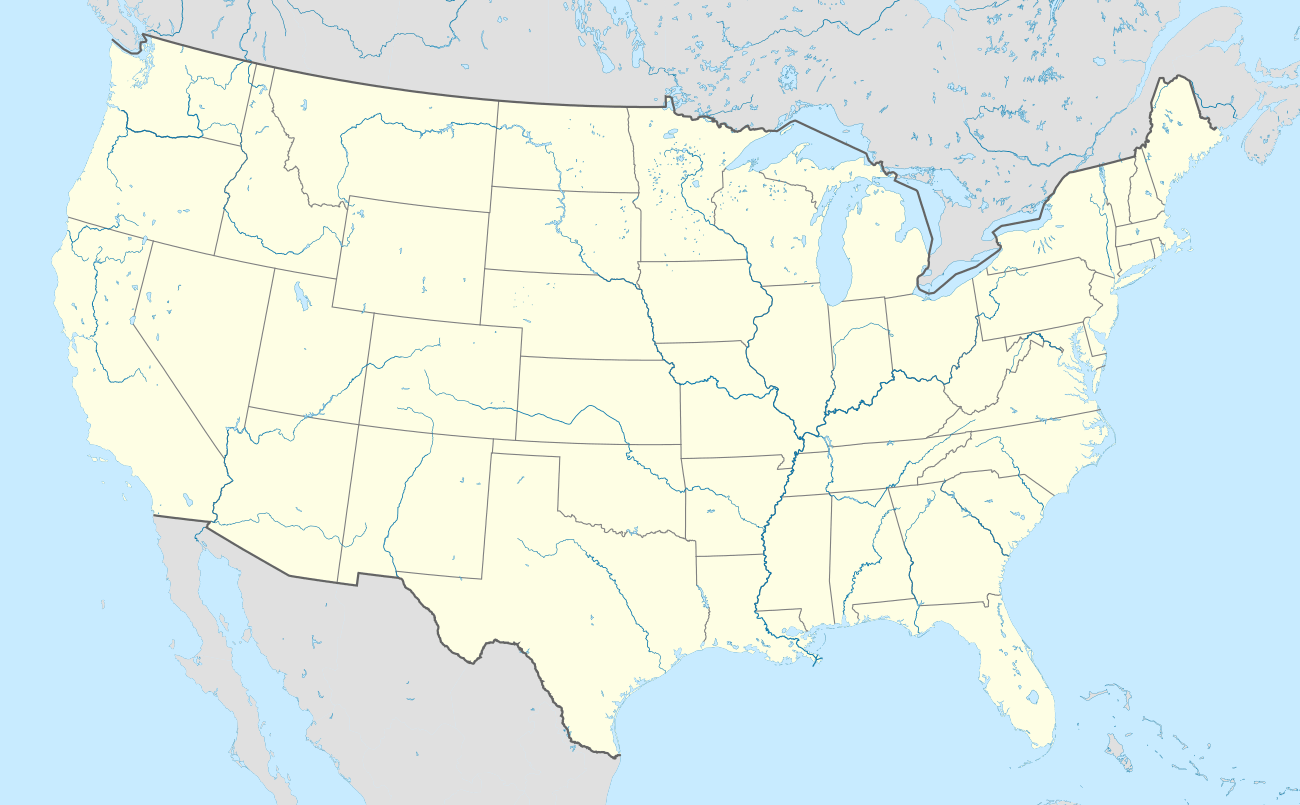 New London Location in the United States and Connecticut 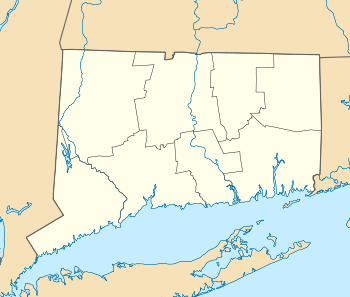 New London New London (Connecticut) | ||
| Coordinates: 41°21′20″N 72°05′58″W / 41.35556°N 72.09944°WCoordinates: 41°21′20″N 72°05′58″W / 41.35556°N 72.09944°W | ||
| Country | United States | |
| State | Connecticut | |
| Region | Southeastern Connecticut | |
| NECTA | Norwich-New London | |
| County | New London County | |
| Settle | 1646 (Pequot Plantation) | |
| Named | 1658 (New London) | |
| Incorporated (city) | 1784 | |
| Government[1][2] | ||
| • Type | Mayor-council | |
| • Mayor |
Michael E. Passero City Council
| |
| Area | ||
| • City | 10.76 sq mi (27.9 km2) | |
| • Land | 5.54 sq mi (14.3 km2) | |
| • Water | 5.23 sq mi (13.5 km2) | |
| • Urban | 123.03 sq mi (318.66 km2) | |
| Elevation | 56 ft (17 m) | |
| Population (2010) | ||
| • City | 27,620 | |
| • Estimate (2016)[3] | 26,984 | |
| • Density | 4,720/sq mi (1,824/km2) | |
| • Metro | 274,055 | |
| Time zone | UTC−5 (EST) | |
| • Summer (DST) | UTC−4 (EDT) | |
| ZIP code | 06320 | |
| Area code(s) | 860 | |
| FIPS code | 09-52280 | |
| GNIS feature ID | 0209237 | |
| Website | ||
New London is a seaport city and a port of entry on the northeast coast of the United States. It is located at the mouth of the Thames River in New London County, Connecticut. It was one of the world's three busiest whaling ports for several decades beginning in the early 19th century, along with Nantucket and New Bedford, Massachusetts. The wealth that whaling brought into the city furnished the capital to fund much of the city's present architecture. New London subsequently became home to other shipping and manufacturing industries, but it has gradually lost its commercial and industrial heart.[4]
New London is home to the United States Coast Guard Academy, Connecticut College, Mitchell College, and The Williams School. The Coast Guard Station New London and New London Harbor is home port to the Coast Guard Cutter Chinook and the Coast Guard's tall ship Eagle. The city had a population of 27,620 at the 2010 census. The Norwich-New London metropolitan area[5]) includes 21 towns[6] and 274,055 people.[7]
History
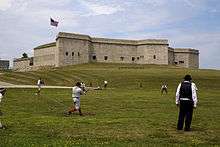
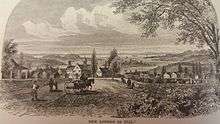
Colonial era
The area was called Nameaug by the Pequot Indians. John Winthrop, Jr. founded the first English settlement here in 1646, making it about the 13th town settled in Connecticut. Inhabitants informally referred to it as Nameaug or as Pequot after the tribe. In the 1650s, the colonists wanted to give the town the official name of London after London, England, but the Connecticut General Assembly wanted to name it Faire Harbour. The citizens protested, declaring that they would prefer it to be called Nameaug if it couldn't be officially named London.[8][9] The legislature relented, and the town was officially named New London on March 10, 1658.
American Revolution
The harbor was considered to be the best deep water harbor on Long Island Sound,[10] and consequently New London became a base of American naval operations during the American Revolutionary War. Famous New Londoners during the American Revolution include Nathan Hale, William Coit, Richard Douglass, Thomas and Nathaniel Shaw, Gen. Samuel Parsons, printer Timothy Green, and Bishop Samuel Seabury.
New London was raided and much of it burned to the ground on September 6, 1781 in the Battle of Groton Heights by Norwich native Benedict Arnold in an attempt to destroy the Revolutionary privateer fleet and supplies of goods and naval stores within the city. It is often noted that this raid on New London and Groton was intended to divert General George Washington and the French Army under Rochambeau from their march on Yorktown, Virginia. The main defensive fort for New London was Fort Griswold, located across the Thames River in Groton. It was well known to Arnold, who sold its secrets to the British fleet so that they could avoid its artillery fire. The British overran New London's Fort Trumbull, while other soldiers moved in to attack Ft. Griswold across the river, commanded by Lieutenant Colonel William Ledyard. The British suffered great casualties at Ft. Griswold before the Americans were finally forced to surrender—whereupon the British stormed into and slaughtered most of the militia who defended it, including Colonel Ledyard. All told, more than 52 British soldiers and 83 militia were killed, and more than 142 British and 39 militia were wounded, many mortally. New London suffered over 6 militia killed and 24 wounded, while Arnold and the British and Hessian raiding party suffered an equal amount.[11]
Connecticut's independent legislature made New London one of the first two cities brought from de facto to formalized incorporations in its January session of 1784, along with New Haven.
19th century
During the War of 1812, torpedoes were employed in attempts to destroy British vessels and protect American harbors. In fact, a submarine-deployed torpedo was used in an unsuccessful attempt to destroy HMS Ramillies while in New London's harbor. This prompted British Capt. Hardy to warn the Americans to cease efforts with the use of any "torpedo boat" in this "cruel and unheard-of warfare", or he would "order every house near the shore to be destroyed."[12]:693
For several decades beginning in the early 19th century, New London was one of the three busiest whaling ports in the world, along with Nantucket and New Bedford, Massachusetts. The wealth that whaling brought into the city furnished the capital to fund much of the city's present architecture.
The New Haven and New London Railroad connected New London by rail to New Haven and points beyond by the 1850s. The Springfield and New London Railroad connected New London to Springfield, Massachusetts by the 1870s.
Military presence
Several military installations have been part of New London's history, including the United States Coast Guard Academy and Coast Guard Station New London.[13] Most of these military installations have been located at Fort Trumbull. The first Fort Trumbull was an earthwork built 1775-1777 that took part in the Revolutionary War. The second Fort Trumbull was built 1839-1852 and still stands. By 1910, the fort's defensive function had been superseded by the new forts of the Endicott Program, primarily located on Fishers Island. The fort was turned over to the Revenue Cutter Service and became the Revenue Cutter Academy. The Revenue Cutter Service was merged into the United States Coast Guard in 1915, and the Academy relocated to its current site in 1932. During World War II, the Merchant Marine Officers Training School was located at Fort Trumbull. From 1950 to 1990, Fort Trumbull was the location for the Naval Underwater Sound Laboratory, which developed sonar and related systems for US Navy submarines. In 1990, the Sound Laboratory was merged with the Naval Underwater Systems Center in Newport, Rhode Island, and the New London facility was closed in 1996.[14][15]
The Naval Submarine Base New London is physically located in Groton, but submarines were stationed in New London from 1951 to 1991. The submarine tender Fulton and Submarine Squadron 10 were at State Pier in New London during this time. Squadron Ten was usually composed of eight to ten submarines and was the first all-nuclear submarine squadron. In the 1990s, State Pier was rebuilt as a container terminal.
Geography
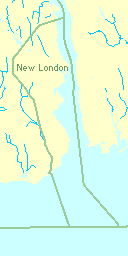
In terms of land area, New London is one of the smallest cities in Connecticut. Of the whole 10.76 square miles (27.9 km2), nearly half is water; 5.54 square miles (14.3 km2) is land.[16]
The town and city of New London are coextensive. Sections of the original town were ceded to form newer towns between 1705 and 1801. The towns of Groton, Ledyard, Montville, and Waterford, and portions of Salem and East Lyme, now occupy what had earlier been the outlying area of New London.[17]
New London is bounded on the west and north by the town of Waterford, on the east by the Thames River and Groton, and on the south by Long Island Sound.
Principal communities
- Downtown
- Ocean Beach
Other minor communities and geographic features are: Bates Woods Park, Fort Trumbull, Glenwood Park, Green's Harbor Beach, Mitchell's Woods, Pequot Colony, Riverside Park, Old Town Mill.
Towns created from New London
New London originally had a larger land area when it was established. Towns set off since include:
- Stonington in 1649
- This large area ran from the Mystic River to the Pawcatuck River, including Pawcatuck, Wequetequock, and the easterly half of Mystic. It stretched inland from Long Island Sound to Lantern Hill.
- Groton in 1705
- Ledyard (originally North Groton) created from a part of Groton in 1836
- Montville in 1786
- Salem created from parts of Montville, Colchester, and Lyme in 1819
- Waterford in 1801
- East Lyme created from parts of Waterford and Lyme in 1839
- Fishers Island officially left Connecticut and became part of New York in 1879.
Climate
New London is classified as having a temperate oceanic climate[18] and lies in the broad transition zone between Continental climates (Köppen climate classification: Dfa) and Temperate climates (Köppen climate classification: cfa) as is typical for much of coastal Connecticut. The city enjoys sunny weather, averaging 2,600 hours of sunshine annually.
In the summer months, the southerly flow from subtropical high pressure (the Atlantic/Bermuda High) often creates hot and humid weather. Daytime heating produces occasional thunderstorms with heavy but brief downpours. Spring and Fall are mild in New London, with daytime highs in the 55 to 70 F range and lows in the 40 to 50 F range. The seaside geography allows a long growing season compared to areas inland. The first frost in the New London area is normally not until early November, almost three weeks later than parts of northern Connecticut. Winters are cool to cold with a mix of rainfall and snowfall, or mixed precipitation. New London normally sees fewer than 25 days annually with snow cover. In mid-winter, there can be large differences in low temperatures between areas along the coastline and areas well inland, often as much as 15 F.
Tropical cyclones (hurricanes/tropical storms) have struck Connecticut and the New London metropolitan area, although infrequently. Hurricane landfalls have occurred along the Connecticut coast in 1903, 1938, 1944, 1954 (Carol), 1960 (Donna), 1985 (Gloria). Tropical Storm Irene (2011) also caused moderate damage along the Connecticut coast, as did Hurricane Sandy (which made landfall in New Jersey) in 2012.
Coastal Connecticut (including New London) is the broad transition zone where so-called "subtropical indicator" plants and other broadleaf evergreens can successfully be cultivated. New London averages about 90 days annually with freeze, about the same as Baltimore, Maryland. As such, Southern Magnolias, Needle Palms, Windmill palm, Loblolly Pines, and Crape Myrtles are grown in private and public gardens. The growing season is quite long in New London, like much of coastal Connecticut and Long Island, NY, averaging 210 days from April 8 to November 5.
| Climate data for Groton–New London Airport (GON) (1981–2010), snow data from Norwich, Connecticut (1981–2010). | |||||||||||||
|---|---|---|---|---|---|---|---|---|---|---|---|---|---|
| Month | Jan | Feb | Mar | Apr | May | Jun | Jul | Aug | Sep | Oct | Nov | Dec | Year |
| Record high °F (°C) | 65 (18) |
67 (19) |
78 (26) |
88 (31) |
91 (33) |
95 (35) |
101 (38) |
99 (37) |
93 (34) |
83 (28) |
75 (24) |
69 (21) |
101 (38) |
| Average high °F (°C) | 37.5 (3.1) |
40 (4) |
46.5 (8.1) |
55.4 (13) |
64.5 (18.1) |
73.3 (22.9) |
78.2 (25.7) |
78.4 (25.8) |
72.3 (22.4) |
61.5 (16.4) |
53 (12) |
42.4 (5.8) |
58.6 (14.8) |
| Daily mean °F (°C) | 29.5 (−1.4) |
32 (0) |
37.8 (3.2) |
47 (8) |
56 (13) |
65.4 (18.6) |
70.6 (21.4) |
70.4 (21.3) |
63.7 (17.6) |
52.7 (11.5) |
44.5 (6.9) |
34.7 (1.5) |
50.4 (10.1) |
| Average low °F (°C) | 21.6 (−5.8) |
23.9 (−4.5) |
29.1 (−1.6) |
38.7 (3.7) |
47.6 (8.7) |
57.6 (14.2) |
62.9 (17.2) |
62.3 (16.8) |
55.1 (12.8) |
43.9 (6.6) |
35.9 (2.2) |
27 (−3) |
42.1 (5.6) |
| Record low °F (°C) | −14 (−26) |
−12 (−24) |
0 (−18) |
14 (−10) |
30 (−1) |
38 (3) |
47 (8) |
41 (5) |
29 (−2) |
22 (−6) |
8 (−13) |
−10 (−23) |
−14 (−26) |
| Average precipitation inches (mm) | 3.27 (83.1) |
2.86 (72.6) |
4.16 (105.7) |
4.41 (112) |
3.85 (97.8) |
4.11 (104.4) |
3.77 (95.8) |
4.16 (105.7) |
4 (100) |
3.86 (98) |
4.31 (109.5) |
3.73 (94.7) |
46.49 (1,179.3) |
| Average snowfall inches (cm) | 8.8 (22.4) |
8.0 (20.3) |
3.6 (9.1) |
0.8 (2) |
0 (0) |
0 (0) |
0 (0) |
0 (0) |
0 (0) |
0 (0) |
0.2 (0.5) |
6.6 (16.8) |
28 (71.1) |
| Average precipitation days (≥ 0.05) | 6 | 5 | 6 | 7 | 8 | 8 | 6 | 6 | 6 | 7 | 7 | 7 | 79 |
| Average snowy days (≥ 0.05) | 3 | 3 | 2 | 0 | 0 | 0 | 0 | 0 | 0 | 0 | 0 | 2 | 10 |
| Source: [19][20] | |||||||||||||
Demographics
| Historical population | |||
|---|---|---|---|
| Census | Pop. | %± | |
| 1800 | 5,150 | — | |
| 1810 | 3,238 | −37.1% | |
| 1820 | 3,330 | 2.8% | |
| 1830 | 4,335 | 30.2% | |
| 1840 | 5,519 | 27.3% | |
| 1850 | 8,991 | 62.9% | |
| 1860 | 10,115 | 12.5% | |
| 1870 | 9,576 | −5.3% | |
| 1880 | 10,537 | 10.0% | |
| 1890 | 13,757 | 30.6% | |
| 1900 | 17,548 | 27.6% | |
| 1910 | 19,659 | 12.0% | |
| 1920 | 25,688 | 30.7% | |
| 1930 | 29,640 | 15.4% | |
| 1940 | 30,456 | 2.8% | |
| 1950 | 30,551 | 0.3% | |
| 1960 | 34,182 | 11.9% | |
| 1970 | 31,630 | −7.5% | |
| 1980 | 28,842 | −8.8% | |
| 1990 | 28,540 | −1.0% | |
| 2000 | 25,671 | −10.1% | |
| 2010 | 27,620 | 7.6% | |
| Est. 2016 | 26,984 | [3] | −2.3% |
| U.S. Decennial Census | |||
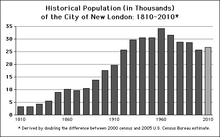
Recent estimates on demographics and economic status
According to the 2006–2008 American Community Survey, non-Hispanic whites made up 54.6% of New London's population. Non-Hispanic blacks made up 14.0% of the population. Asians of non-Hispanic origin made up 4.6% of the city's population. Multiracial individuals of non-Hispanic origin made up 4.3% of the population; people of mixed black and white ancestry made up 1.7% of the population. In addition, people of mixed black and Native American ancestry made up 1.0% of the population. People of mixed white and Native American ancestry made up 0.7% of the population; those of mixed white and Asian ancestry made up 0.4% of the populace. Hispanics and Latinos made up 21.9% of the population, of which 13.8% were Puerto Rican.[21]
The top five largest European ancestry groups were Italian (10.5%), Irish (9.7%), German (7.4%), English (6.8%) and Polish (5.0%)
According to the survey, 74.4% of people over the age of 5 spoke only English at home. Approximately 16.0% of the population spoke Spanish at home.[22]
In 2012, the population reached 27,700. The median household income was $44,100, with 20% of the population below the poverty line.
2000 census
As of the census[23] of 2000, there were 25,671 people, 10,181 households, and 5,385 families residing in the city. The population density was 4,635.5 per square mile (1,789.8/km2). There were 11,560 housing units at an average density of 2,087.4 per square mile (805.9/km2). The racial makeup of the city was 63.49% White, 19.71% Hispanic or Latino of any race, 18.64% African American, 0.88% Native American, 2.12% Asian, 0.08% Pacific Islander, 9.13% from other races, and 5.67% from two or more races.
There were 10,181 households out of which 27.6% had children under the age of 18 living with them, 30.4% were married couples living together, 17.8% had a female householder with no husband present, and 47.1% were non-families. 37.8% of all households were made up of individuals and 10.7% had someone living alone who was 65 years of age or older. The average household size was 2.26 and the average family size was 3.00.
In the city, the population was spread out with 22.8% under the age of 18, 17.6% from 18 to 24, 29.6% from 25 to 44, 17.9% from 45 to 64, and 12.1% who were 65 years of age or older. The median age was 31 years. For every 100 females, there were 95.5 males. For every 100 females age 18 and over, there were 93.8 males.
The median income for a household in the city was $33,809, and the median income for a family was $38,942. Males had a median income of $31,405 versus $25,426 for females. The per capita income for the city was $18,437. About 13.4% of families and 15.8% of the population were below the poverty line, including 23.5% of those under age 18 and 11.4% of those age 65 or over.
Arts and culture
Eugene O'Neill
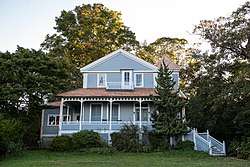
The family of Nobel laureate and Pulitzer Prize-winning playwright Eugene O'Neill (1888-1953) were intimately connected to New London. He lived here for years and wrote several plays in the city. A major O'Neill archive is located at Connecticut College, and the family home "Monte Cristo Cottage"[24] in New London is a museum and registered national historic landmark operated by the Eugene O'Neill Theater Center. Dutch's Tavern on Green Street was a favorite watering hole of Eugene O'Neill and still stands today.
Music
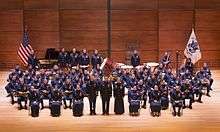
Notable artists and ensembles include:
- Eastern Connecticut Symphony Orchestra, founded in 1946 and led by Toshiyuki Shimada, who is also conductor of the Yale Symphony Orchestra in New Haven.
- The Idlers of the United States Coast Guard Academy, an all-male vocal group specializing in sea shanties and patriotic music.
- United States Coast Guard Band, founded in 1925 with the assistance of John Philip Sousa. Stationed at the United States Coast Guard Academy and attracting talented musicians from all parts of the country, the band is the official musical representative of the nation's oldest continuous seagoing service.
- The Can Kickers, a folk punk band.
Sites of interest
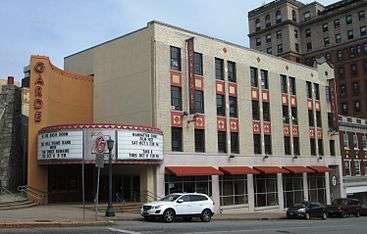
- Lyman Allyn Art Museum
- Ocean Beach Park[25]
- New London County Historical Society, Shaw-Perkins Mansion (1758)[26]
- New London Maritime Society, U.S. Custom House (1833),[27] landing site of Amistad (1839)
- Fishers Island (7 miles off the coast of New London, but part of New York)[28]
- Connecticut College Arboretum
- Fort Griswold (Groton)
- Fort Trumbull
- Coast Guard Station New London
- Flock Theatre[29]
- Garde Arts Center[30]
- Hygienic Arts Gallery[31]
- Joshua Hempsted House (1678)[32]
- Monte Cristo Cottage & Eugene O'Neill Theater Center (Waterford)[33]
- Ye Antientist Burial Ground
- Winthrop Mill (1650)
- Former Second Congregational Church (1870)[34]
Government
In 2010, New London changed their form of government from council-manager to strong mayor-council after a charter revision.[35] Distinct town and city government structures formerly existed and technically continue; however, they now govern exactly the same territory and have elections on the same ballot on Election Day in November.
Fort Trumbull controversy
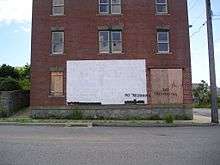
The neighborhood of Fort Trumbull once consisted of nearly two-dozen homes, but they were seized by the City of New London using eminent domain. This measure was supported in the 2005 Supreme Court ruling of Kelo v. City of New London, and the homes were ultimately demolished by the city as part of an economic development plan. The site was slated to be redeveloped under this plan, but the chosen developer was not able to get financing and the project failed. The empty landscape of the Fort Trumbull area has been characterized by some as an example of government overreach and inefficiency.[36][37][38]
Transportation
Downtown New London is served by regional Southeast Area Transit buses, the Estuary Transit District public transit service between the New London transportation center and Old Saybrook, and interstate Greyhound Lines buses. Interstate 95 passes through the New London.
New London has frequent passenger rail service. New London Union Station is served by Amtrak's Northeast Regional and Acela Express regional rail services, plus Shore Line East (SLE) commuter rail service. The Providence & Worcester Railroad and the New England Central Railroad handle freight.
The city is also served by Cross Sound Ferry to Long Island, the Fishers Island Ferry District, and the Block Island Express ferry. New London is also visited by cruise ships.[39]
The Groton-New London Airport, a general aviation facility, is located in Groton. Scheduled commercial flights are available at T. F. Green and the much smaller Tweed New Haven Regional Airport. The larger Bradley International Airport is 75 minutes driving time.
Notable people
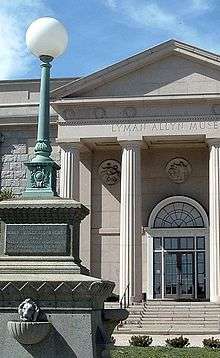
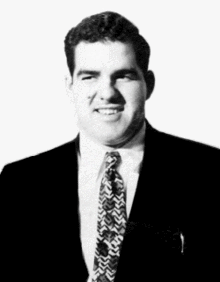
- Eliphalet Adams (1677–1753), clergyman
- Theresa Andrews (born 1962), winner of two Olympic gold medals
- Peter C. Assersen (1839–1906), Rear Admiral in the United States Navy
- James Avery (1620–1700), politician and military commander
- Nathan Belcher (1813–1891), congressman
- Augustus Brandegee (1828–1904), judge, congressman, abolitionist
- Frank B. Brandegee (1864–1924), congressman and senator
- Amy Brenneman (born 1964), actress
- Valerie Azlynn (born 1980), actress
- Henry Burbeck (1754–1848), brigadier general
- Daniel Burrows (1756–1858), congressman
- Thomas Humphrey Cushing (1755-1822), brigadier general in the War of 1812 and collector of customs
- Harry Daghlian (1921–1945), physicist at Los Alamos National Lab, first person to die as a result of a criticality accident
- David Dorfman (born 1955), choreographer
- Richard Douglass (1746–1828), cooper and soldier
- Doug DuBose (born 1964), NFL player
- Kris Dunn (born 1994), point guard for the Chicago Bulls
- Larry Elgart (born 1922), musician
- John Ellis (born 1948), baseball player
- Elsie Ferguson (1883-1961), stage and film actress
- Richard P. Freeman (1869–1944), congressman
- L. Patrick Gray (1916–2005), lawyer and Watergate figure
- Nathan Hale (1755–1776), schoolmaster and patriot
- Doc Hammer (born 1967), multimedium artist and co-creator of the Venture Brothers
- Matt Harvey (born 1989), MLB pitcher for the Cincinnati Reds
- Glenne Headly (1955–2017), actress
- Barkley L. Hendricks (born 1945), painter
- Linda Jaivin (born 1955), Australian author[40]
- Sarah Kemble Knight (1666–1727), diarist, teacher and businesswoman
- John Law (1796–1873), congressman
- Bryan F. Mahan (1856–1923), congressman
- Richard Mansfield (1857–1907), actor
- John McCain (1936–2018), senator and Republican presidential nominee (lived in New London as a child when his father, John S. McCain, Jr., worked at the naval submarine base)
- Thomas Minor (1608–1690), founder and early New England diarist
- Casey Neistat (born 1981), filmmaker
- James O'Neill (1847–1920), actor, father of Eugene O'Neill
- Eugene O'Neill (1888–1953), playwright
- Walter Palmer (1585–1661), founder
- Elias Perkins (1767–1845), congressman
- Mary Philips (1901–1975), actress
- Edward Clark Potter (1857–1923), sculptor
- Renee Prahar (1879-1962), sculptor
- Art Quimby (1933–2010), basketball player
- Jordan Reed (born 1990), tight end for the Washington Redskins
- Tim Riordan (born 1960), gridiron football player
- Dawn Robinson (born 1965), singer
- Dudley Saltonstall (1738–1796), naval officer
- "Magic Dick" Salwitz (born 1945), musician
- Thomas R. Sargent III (1914–2010), Vice Admiral in the United States Coast Guard
- Samuel Seabury (1729–1796), bishop
- Benjamin Stark (1820–1898), senator
- Dana Suesse (1909–1987), composer, songwriter, musician
- Ron Suresha, author and editor
- Cassie Ventura (born 1986), singer
- John T. Wait (1811–1899), former U.S. Representative for Connecticut[41]
- Thomas M. Waller (1839–1924), Mayor of New London and 51st Governor of Connecticut
- John Winthrop the Younger (1606–1676), statesman and founder
- Tyson Wheeler (born 1975), former Denver Nuggets basketball player[42]
- Abisha Woodward (1752–1809), early American lighthouse builder[43]
References
- ↑ "Office of the Mayor". City of New London, Connecticut. Retrieved June 11, 2017.
- ↑ "Council Members". City of New London, Connecticut. Retrieved June 11, 2017.
- 1 2 "Population and Housing Unit Estimates". Retrieved June 9, 2017.
- ↑ Downey, Kirstin (May 22, 2005). "Nation & World | Supreme Court ruling due on use of eminent domain". Seattle Times. Retrieved October 28, 2011.
- ↑ "About Metropolitan and Micropolitan Statistical Areas". Census.gov. August 19, 2008. Retrieved October 28, 2011.
- ↑
- ↑ "CBSA 01". Census.gov. Archived from the original on March 11, 2007. Retrieved January 26, 2017.
- ↑ Richard B. Marrin (1 January 2007). Abstracts from the New London Gazette Covering Southeastern Connecticut, 1763-1769. Heritage Books. p. 242. ISBN 978-0-7884-4171-4.
- ↑ Frances Manwaring Caulkins, History of New London, Connecticut, from the first survey of the coast in 1612 to 1860, Library of Congress, 1895.
- ↑

- ↑ "The Battle of Groton Heights & Burning of New London". Battleofgrotonheights.com. August 31, 2006. Retrieved October 28, 2011.
- ↑ Lossing, Benson (1868). The Pictorial Field-Book of the War of 1812. Harper & Brothers, Publishers. p. 692.
- ↑ Coast Guard Station New London official web page
- ↑ The History of Fort Trumbull by John Duchesneau
- ↑ Fort Trumbull History Site
- ↑ "New London County, Connecticut – County Subdivision and Place". American FactFinder. United States Census Bureau. Retrieved October 28, 2011.
- ↑ Archived March 14, 2008, at the Wayback Machine.
- ↑ "Climate New London: Temperature, Climograph, Climate table for New London - Climate-Data.org". en.climate-data.org. Retrieved 28 December 2017.
- ↑ "NOWData-NOAA Online Weather Data". Applied Climate Information System. Retrieved January 24, 2017.
- ↑ "Historic Averages-New London, Connecticut". The Weather Company. Retrieved January 24, 2017.
- ↑ "New London city, Connecticut – ACS Demographic and Housing Estimates: 2006–2008". American FactFinder. United States Census Bureau. Retrieved October 28, 2011.
- ↑ "New London city, Connecticut – Selected Social Characteristics in the United States: 2006–2008". American FactFinder. United States Census Bureau. Retrieved October 28, 2011.
- ↑ "American FactFinder". United States Census Bureau. Archived from the original on September 11, 2013. Retrieved 2008-01-31.
- ↑ "Monte Cristo Cottage". theoneill.com.
- ↑ Ocean Beach Park
- ↑ New London Historical Society
- ↑ New London Maritime Society
- ↑ Fishers Island
- ↑ Flock Theatre
- ↑ Garde Arts Center
- ↑ Hygienic Arts
- ↑ Joshua Hempsted House Connecticut Landmarks
- ↑ Eugene O'Neill Theater Center
- ↑ Morrison, Betty Urban (1985). The Church on the Hill: A history of the Second Congregational Church, New London, Connecticut 1835-1985. New London, Connecticut: Second Congregational Church. p. 17.
- ↑ "New Face Stirs Up Historic New London Election". tribunedigital-thecourant. Retrieved 2017-11-21.
- ↑ Jacoby, Jeff (March 12, 2014). "Eminent disaster: Homeowners in Connecticut town were dispossessed for nothing". The Boston Globe.
- ↑ Allen, Charlotte (Feb 10, 2014). "'Kelo' Revisited". Weekly Standard. Retrieved 23 October 2014.
- ↑ Somin, Ilya (May 29, 2015). "The story behind Kelo v. City of New London – how an obscure takings case got to the Supreme Court and shocked the nation". The Washington Post.
- ↑ Howard, Lee (September 7, 2013). "Cruise ships returning to New London". The Day. Retrieved 28 August 2018.
- ↑ Bio, Linda Jaivin's web site
- ↑ "WAIT, John Turner, (1811 - 1899)". Biographical Directory of the United States Congress. Retrieved October 10, 2012.
- ↑ Keefe, Gavin (March 20, 2015). "Wheeler on Dunn: New London basketball legend talks about legend-to-be". The New London Day. Retrieved August 13, 2015.
- ↑ Griswold, Wick (2012). A History of the Connecticut River. The History Press. pp. 96–97. ISBN 9781609494056. Retrieved April 13, 2016.
External links
| Wikimedia Commons has media related to New London, Connecticut. |
| Wikivoyage has a travel guide for New London, Connecticut. |
| Wikisource has the text of The New Student's Reference Work article New London, Ct.. |

